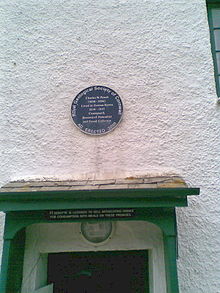- Charles William Peach
-
Charles William Peach (September 30, 1800-February 28, 1886) was a British naturalist and geologist.
Biography
 Plaque commemorating C. W. Peach, placed on the former Customs House at Gorran Haven, Cornwall, UK by the Royal Geological Society of Cornwall
Plaque commemorating C. W. Peach, placed on the former Customs House at Gorran Haven, Cornwall, UK by the Royal Geological Society of Cornwall
He was born at Wansford, Cambridgeshire; his father at the time was a saddler and harness-maker, and afterwards became an innkeeper, farming about eighty acres (0.32 km²) of land. He received an elementary education at Wansford and at Folkingham in Lincolnshire; and assisted for several years in the inn and farm.
In 1824 he was appointed riding officer in the HM Coastguard at Weybourne in Norfolk. Seaweeds and other marine organisms now attracted his attention, and these he zealously collected. His duties during the next few years led him to remove successively to Sheringham, Hasboro (Happisburgh), Cromer, and Cley, all in Norfolk.
In the course of his rambles he met the Rev. James Layton, curate at Catfield, who lent him books and assisted in laying the foundations of accurate knowledge. About the year 1830 he was transferred to Charmouth in Dorset, thence to Beer, and Paignton in Devon, and to Gorran Haven near Mevagissey in Cornwall.
Here he continued to pursue his zoological studies and supplied many specimens to George Johnston, who was then preparing his History of the British Zoophytes (1838). It was here too that he first found fossils in some of the older rocks previously regarded as not fossil-bearing; the discovery of which proved the presence of Bala Beds (Ordovician or Lower Silurian) in the neighbourhood of Gorran Haven.
In 1841 he read a paper before the British Association at Plymouth On the Fossil Organic Remains found on the south-east coast of Cornwall, and in 1843 he brought before the Royal Geological Society of Cornwall an account of his discovery of fish remains in the Devonian slates near Polperro. Peach was transferred for a time to Fowey; and in 1849 to Scotland, first to Peterhead (1849) and then to Wick (1853), where he made acquaintance with Robert Dick of Thurso. During his stay in Peterhead he met with Hugh Miller and collected 'Buchan Flints'. He collected the old red sandstone fishes; and during a sojourn at Durness he first found fossils in the Cambrian limestone (1854). Peach was honoured with medals from the Royal Cornwall Polytechnic Society.[1]
He supplied Charles R. Darwin with cirripede (barnacle) specimens collected on the Cornish coast prior to his move to Peterhead.
Later life
Peach retired from the government service in 1861. He and his household moved to Edinburgh in May 1865 whereupon he commenced a new field of research and study into the plant fossils of the Carboniferous rocks of the area. He died at Edinburgh on 28 February 1886.
One of his sons was the geologist Ben Peach.
References
- ^ David Oldroyd, ‘Peach, Charles William (1800–1886)’, Oxford Dictionary of National Biography, Oxford University Press, 2004 accessed 16 Nov 2007
 This article incorporates text from a publication now in the public domain: Chisholm, Hugh, ed (1911). Encyclopædia Britannica (11th ed.). Cambridge University Press.
This article incorporates text from a publication now in the public domain: Chisholm, Hugh, ed (1911). Encyclopædia Britannica (11th ed.). Cambridge University Press.- Biographical notice, with portrait, in S. Smiles's Robert Dick Baker, of Thurso, Geologist and Botanist (1878).
- Crowther, Peter R. 2003. The Charles W. Peach (1800 - 1886) collection of Cornish fossils. The Geological Curator 7 (9): 323 - 328.
- Anderson, L. I. & Taylor, M. A. 2008. Charles W. Peach, Palaeobotany and Scotland. The Geological Curator 8 (9): 393 -425.
- Anderson, L. I. & Lowe, M. 2010. Charles W. Peach and Darwin's Barnacles. Journal of the History of Collections, 22 (2), 257 - 270.
Categories:- 1800 births
- 1886 deaths
- British geologists
Wikimedia Foundation. 2010.
